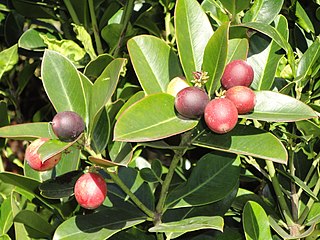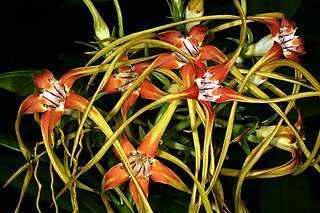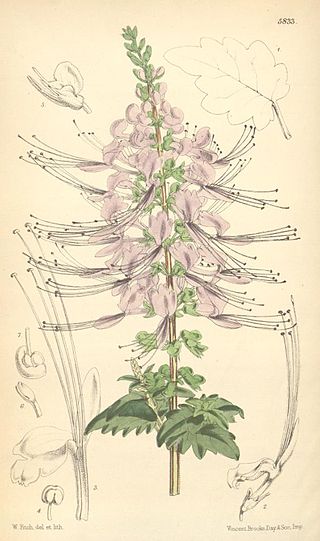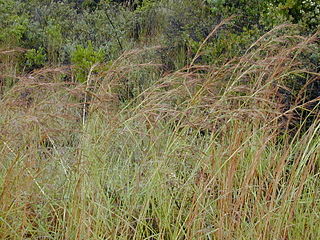
Abrus is a genus of flowering plants in the pea family, Fabaceae, and the only genus in the tribe Abreae. It contains 13–18 species, but is best known for a single species: jequirity. The highly toxic seeds of that species are used to make jewellery.

Apocynaceae is a family of flowering plants that includes trees, shrubs, herbs, stem succulents, and vines, commonly known as the dogbane family, because some taxa were used as dog poison. Members of the family are native to the European, Asian, African, Australian, and American tropics or subtropics, with some temperate members. The former family Asclepiadaceae is considered a subfamily of Apocynaceae and contains 348 genera. A list of Apocynaceae genera may be found here.

Ouabain or also known as g-strophanthin, is a plant derived toxic substance that was traditionally used as an arrow poison in eastern Africa for both hunting and warfare. Ouabain is a cardiac glycoside and in lower doses, can be used medically to treat hypotension and some arrhythmias. It acts by inhibiting the Na/K-ATPase, also known as the sodium–potassium ion pump. However, adaptations to the alpha-subunit of the Na+/K+-ATPase via amino acid substitutions, have been observed in certain species, namely some herbivore- insect species, that have resulted in toxin resistance.

Kniphofia is a genus of perennial flowering plants in the family Asphodelaceae, first described as a genus in 1794. All species of Kniphofia are native to Africa. Common names include tritoma, red hot poker, torch lily and poker plant.

Strychnos nux-vomica, the strychnine tree, also known as nux vomica, poison fruit, semen strychnos, and quaker buttons, is a deciduous tree native to India and to southeast Asia. It is a medium-sized tree in the family Loganiaceae that grows in open habitats. Its leaves are ovate and 5–9 centimetres (2–3.5 in) in size. It is known for being the natural source of the extremely poisonous compound strychnine.

The maned rat or (African) crested rat is a nocturnal, long-haired and bushy-tailed East African rodent that superficially resembles a porcupine. The world's only known poisonous rodent, the maned rat sequesters toxins from plants to fend off predators.

Ocimum is a genus of aromatic annual and perennial herbs and shrubs in the family Lamiaceae, native to the tropical and warm temperate regions of all 6 inhabited continents, with the greatest number of species in Africa. It is the genus of basil and its best known species are the cooking herb great basil, O. basilicum, and the medicinal herb tulsi, O. tenuiflorum.

Acokanthera oppositifolia, the poison arrow tree, is a shrub used as the source of an arrow poison and to coat caltrops made from the sharp fruits of the puncture vine. All plants of the genus Acokanthera contain toxic cardiac glycosides strong enough to cause death. Acokanthera oppositifolia is widespread in southern and central Africa from Cape Province north to The Democratic Republic of the Congo + Tanzania.

Carissa is a genus of shrubs or small trees native to tropical and subtropical regions of Africa, Australia and Asia. Until recently about 100 species were listed, but most of them have been relegated to the status of synonyms or assigned to other genera, such as Acokanthera.

Strophanthus is a genus of flowering plants in the family Apocynaceae, first described as a genus in 1802. It is native primarily to tropical Africa, extending to South Africa, with a few species in Asia from southern India to New Guinea and southern China. The genus name is a compound of the Greek words στρόφος (stróphos) "twisted cord" and ἄνθος (ánthos) "flower", in reference to the corolla lobes which, in some species - notably S. petersianus - resemble long twisted ribbons or threads and can reach a length of 30–35 cm. This trait, in addition to colouring involving combinations of bright pinks, purples and oranges, combine to make the flowers among the most ornamental in the plant kingdom.
Arrow poisons are used to poison arrow heads or darts for the purposes of hunting and warfare. They have been used by indigenous peoples worldwide and are still in use in areas of South America, Africa and Asia. Notable examples are the poisons secreted from the skin of the poison dart frog, and curare, a general term for a range of plant-derived arrow poisons used by the indigenous peoples of South America.

Orthosiphon is a genus of plants in the family Lamiaceae native to Africa, Southern Asia and Queensland, with one species (O. americanus) in Colombia. They are herbaceous shrubs which grow to a height of 1.5 m (5 ft). Some Orthosiphon species are popular garden plants because of their flowers, which are white and bluish with filaments resembling a cat's whiskers. In the wild, the plants can be seen growing in forests and along roadsides.

Adenium obesum, more commonly known as a desert rose, is a poisonous species of flowering plant belonging to the tribe Nerieae of the subfamily Apocynoideae of the dogbane family, Apocynaceae. It is native to the Sahel regions south of the Sahara, tropical and subtropical eastern and southern Africa, as well as the Arabian Peninsula. Other names for the flower include Sabi star, kudu, mock azalea, and impala lily. Adenium obesum is a popular houseplant and bonsai in temperate regions.

Acokanthera schimperi, arrow poison tree, belonging to the family Apocynaceae, is a small tree native to eastern and central Africa as well as to Yemen.

Hyparrhenia is a genus of grasses. Many species are known commonly as thatching grass.

Antiaris toxicaria is a tree in the mulberry and fig family, Moraceae. It is the only species currently recognized in the genus Antiaris. The genus Antiaris was at one time considered to consist of several species, but is now regarded as just one variable species which can be further divided into five subspecies. One significant difference within the species is that the size of the fruit decreases as one travels from Africa to Polynesia. Antiaris has a remarkably wide distribution in tropical regions, occurring in Australia, tropical Asia, tropical Africa, Indonesia, the Philippines, Tonga, and various other tropical islands. Its seeds are spread by various birds and bats, and it is not clear how many of the populations are essentially invasive. The species is of interest as a source of wood, bark cloth, and pharmacological or toxic substances.

Adenium boehmianum, the Bushman poison, is a poisonous succulent endemic to the mostly dry regions of northern Namibia and southern Angola. The San people boil the root sap and latex to prepare arrow poison, which is sufficient for hunting large mammals, as it contains strong cardiotoxic effects. The leaves, borne only for three months a year, are arranged spirally and are clustered near the branch tips. A plant will flower for only a few weeks in winter. The oblong fruit releases many seeds through a longitudinal slit, which due to their lateral tufts, can be dispersed by wind.
Bushman poison can refer to a number of plants or insects used as ingredients by the San people when preparing arrow poisons:

Acokanthera oblongifolia is a plant in the family Apocynaceae. It grows as an evergreen shrub or small tree up to 6 metres (20 ft) tall. Its fragrant flowers feature a white tinged pink corolla. The berries are purple when ripe. Its habitat is dry forest and coastal thickets. Acokanthera oblongifolia is used in local African medicinal treatments for snakebites, itches and internal worms. The plant has been used as arrow poison. The species is native to Mozambique and South Africa.

Tetradenia (gingerbush) is a genus of plants in the family Lamiaceae, first described in 1830. It is native to Africa, including Madagascar.
- Tetradenia bainesii(N.E.Br.) Phillipson & C.F.Steyn - Zimbabwe, Mozambique, Eswatini, KwaZulu-Natal
- Tetradenia barberae(N.E.Br.) Codd - Cape Province
- Tetradenia brevispicata(N.E.Br.) Codd - Zimbabwe, Namibia, Botswana, Transvaal
- Tetradenia clementianaPhillipson - Madagascar
- Tetradenia cordataPhillipson - Madagascar
- Tetradenia discolorPhillipson - Zambia, Zaire, Zimbabwe, Malawi, Tanzania
- Tetradenia falafaPhillipson - Madagascar
- Tetradenia fruticosaBenth. - Madagascar
- Tetradenia galpinii(N.E.Br.) Phillipson & C.F.Steyn - southeast Africa from Tanzania to Eswatini
- Tetradenia goudotiiBriq. - Madagascar
- Tetradenia herbacea Phillipson - Madagascar
- Tetradenia hildeanaPhillipson - Madagascar
- Tetradenia isaloensisPhillipson - Madagascar
- Tetradenia kaokoensisvan Jaarsv. & A.E.van Wyk - Namibia
- Tetradenia multiflora(Benth.) Phillipson - Ethiopia
- Tetradenia nervosaCodd - Madagascar
- Tetradenia riparia(Hochst.) Codd - southern Africa from Angola + Malawi to Eswatini
- Tetradenia tanganyikaePhillipson - Malawi, Tanzania, Zambia
- Tetradenia tuberosaT.J.Edwards - KwaZulu-Natal
- Tetradenia urticifolia(Baker) Phillipson - eastern + central Africa from Sudan + Eritrea south to Zaire and Tanzania



















